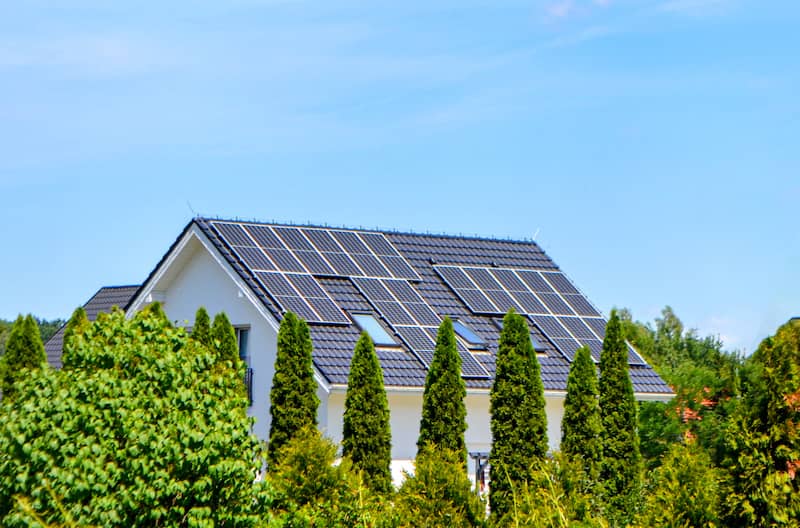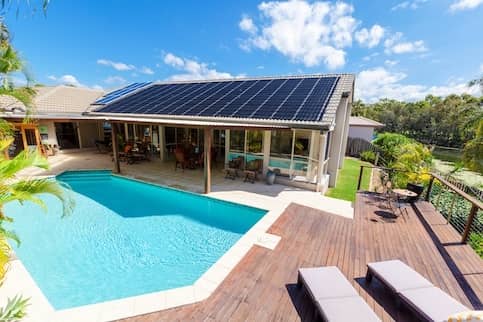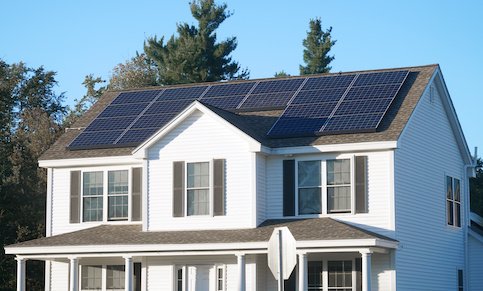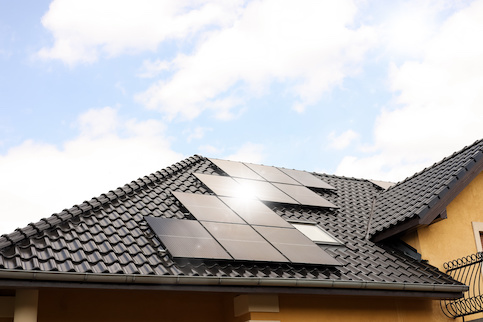It’s a good idea for homeowners to know as much as possible about solar power prior to making the commitment to get solar panels for their home.
For example, here’s a major question you may want to have answered before solar installation: “How much energy does a solar panel produce?” Let’s dig into the answer.
Find A Mortgage Today and Lock In Your Rate!
Get matched with a lender that will work for your financial situation.
How Do Solar Panels Work?
Residential solar panel installation rose from 2.9 gigawatts in 2020 to 3.9 gigawatts in 2021, according to the U.S. Energy Information Administration (EIA), a government agency.
Do you know how solar panels work? Put very simply, solar energy is created when the sun shines on photovoltaic panels that make up your solar panel system. These cells convert the sun’s energy into electricity when sunlight is absorbed by PV cells. This creates electrical charges and causes electricity to flow. The amount of electricity produced depends on a few factors, which we’ll get into in the next section.
Solar panels offer a renewable source of energy, reduction in electric bills, insurance against rising energy costs, environmental benefits and energy independence.
See What You Qualify For
Buy A Home
Discover mortgage options that fit your unique financial needs.

Refinance
Refinance your mortgage to have more money for what matters.
Tap Into Equity
Use your home’s equity and unlock cash to achieve your goals.
How Much Energy Does One Solar Panel Produce?
How much energy can a solar panel produce? The amount of energy produced by a solar panel per day, also called “wattage” and measured by kilowatt-hours, depends on many factors, such as peak sunlight hours and panel efficiency. Most solar panels for homes generate around 250 – 400 watts but for larger homes, can produce up to 750 – 850 per kilowatt hour annually.
Solar panel manufacturers determine the solar power output for products based on zero obstructions. But in reality, the amount of solar energy a panel produces varies depending on the power output of the panel and the number of peak sun hours where the solar power system on a home is located. Use the information from the manufacturer as a starting point as a calculation for your home.
How To Calculate How Many Watts A Solar Panel Produces
How many watts does a solar panel produce? “Watts” refer to a panel’s expected power production amount under perfect sunlight, temperature and other conditions. You can calculate how much a solar panel produces by multiplying the solar panel power output by your local peak sun hours per day:
Kilowatt-hours (kWh) = (Hours of sunlight x Watts)/1,000
In other words, let’s say you get 6 hours of direct sunlight every day. Multiply that by the wattage of a manufacturer’s panel, such as 300 watts.
Kilowatt-hours (kWh) = (6 hours x 300 watts)/1,000
In this case, the number of kilowatt-hours produced would be 1.8 kWh. Next, calculate the following for the number of kWh per year using the following formula:
(1.8 kWh/day) x (365 days/year) = 657 kWh per year
In this case, the solar panel output of this particular panel would generate 657 kWh per year in power output.
What Impacts How Much Power A Solar Panel Generates?
As we’ve mentioned, many factors impact solar panel energy production, including solar panel size, peak sunlight hours, solar panel efficiency and physical obstructions:
- Solar panel size: Solar panel size can affect the amount of solar energy produced by solar panels. The number of solar cells inside a panel can impact the amount of energy it produces. Solar panels typically have either 60 or 72 cells – in most cases, 72 cells produce more electricity.
- Peak sunlight hours: Peak sunlight hours are important in solar energy production because they help you determine the number of hours of intense sunlight you get and can help you determine the amount of electricity your solar panels can produce.
- Solar panel efficiency: Solar energy panel efficiency directly impacts solar energy production because it measures the amount of energy output in a particular surface area. For example, “monocrystalline” and “polycrystalline” are two different types of solar panels – monocrystalline solar cells use single-crystal silicone, which is a thin, efficient material. They offer more efficiency because electrons that generate electricity can move. Polycrystalline solar cells usually have lower efficiency than monocrystalline solar cells and are less expensive. Manufacturers melt silicon crystals together, which means electrons move less freely. Monocrystalline cells have an efficiency rating of 15% – 20% and polycrystalline cells have an efficiency rating of 13% – 16%.
- Lack of physical obstructions: How much power might you produce if you have a lot of trees over your house or other obstructions? Naturally, the answer to “how much power can a solar panel generate?” will depend on the amount of sunlight that can get through to your solar panels.
Solar Panel FAQs
How much power does a solar panel produce in a day?
Solar power from a single panel in a solar panel system typically produces about 2 kWh per day. However, the amount a single panel will produce depends on a wide variety of factors.
How much does a solar panel cost?
Solar panel cost depends on the type of solar panel you choose. For example, monocrystalline panels cost $1 – $1.50 per watt, while polycrystalline solar panels cost $0.90 – $1.
How many solar panels would I need to fully power my home?
The number of solar panels you may need to provide an adequate amount of electricity can vary. You can determine how many solar panels you need to power your home based on your own energy consumption, panel wattage and even the kind of weather you get.
How can I increase solar panel efficiency?
You know the answer to “How much energy does one solar panel produce?” Now, how can homeowners increase the efficiency of their solar panels? Consider buying a high efficiency system, placing them in an ideal sunny spot and keeping the panels as clean as possible.
The Bottom Line: The Amount of Energy A Solar Panel Generates Can Vary
How much energy do solar panels produce? The short answer: it varies. Solar panels generate different amounts of power based on solar panel size, peak sunlight hours, solar panel efficiency and physical obstructions. One set of panels on one house can produce a completely different amount of electricity compared to another based on this wide variety of factors.
Find A Mortgage Today and Lock In Your Rate!
Get matched with a lender that will work for your financial situation.

Melissa Brock
Melissa Brock is a freelance writer and editor who writes about higher education, trading, investing, personal finance, cryptocurrency, mortgages and insurance. Melissa also writes SEO-driven blog copy for independent educational consultants and runs her website, College Money Tips, to help families navigate the college journey. She spent 12 years in the admission office at her alma mater.












